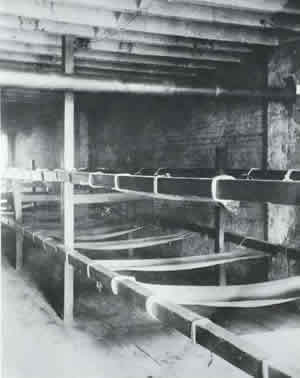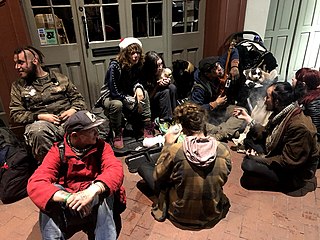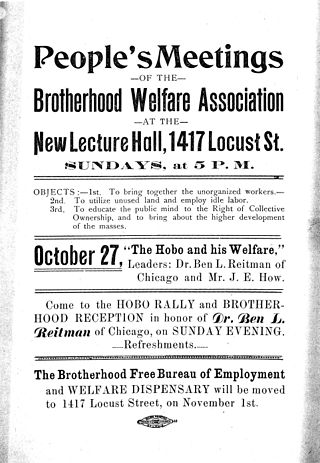
A tramp is a long-term homeless person who travels from place to place as a vagrant, traditionally walking all year round.

A hobo is a migrant worker in the United States. Hoboes, tramps, and bums are generally regarded as related, but distinct: a hobo travels and is willing to work; a tramp travels, but avoids work if possible; a bum neither travels nor works.

Chula Vista is a city in San Diego County, California, United States. It is the second-most populous city in the San Diego metropolitan area, the seventh-most populous city in Southern California, the 15th-most populous city in the state of California, and the 82nd-most populous city in the United States. The population was 275,487 as of the 2020 census, up from 243,916 as of the 2010 census. Located in the South Bay, about halfway—7.5 miles (12.1 km)—between the two downtowns of the San Diego–Tijuana transborder metropolitan area. Chula Vista is named for its scenic location between San Diego Bay and coastal mountain foothills.

A skid row, also called skid road, is an impoverished area, typically urban, in English-speaking North America whose inhabitants are mostly poor people "on the skids". This specifically refers to people who are poor or homeless, considered disreputable, downtrodden or forgotten by society. A skid row may be anything from an impoverished urban district to a red-light district to a gathering area for people experiencing homelessness or drug addiction. In general, skid row areas are inhabited or frequented by impoverished individuals and also people who are addicted to drugs. Urban areas considered skid rows are marked by high vagrancy, dilapidated buildings, and drug dens, as well as other features of urban blight. Used figuratively, the phrase may indicate the state of a poor person's life.

The Chinatown–International District of Seattle, Washington is the center of the city's Asian American community. Within the district are the three neighborhoods known as Chinatown, Japantown and Little Saigon, named for the concentration of businesses owned by people of Chinese, Japanese and Vietnamese descent, respectively. The geographic area also once included Manilatown.

Hoovervilles were shanty towns built during the Great Depression by the homeless in the United States. They were named after Herbert Hoover, who was President of the United States during the onset of the Depression and was widely blamed for it. The term was coined by Charles Michelson. There were hundreds of Hoovervilles across the country during the 1930s.

In the United States, the number of homeless people on a given night in January 2023 was more than 650,000 according to the Department of Housing and Urban Development. Homelessness has increased in recent years, in large part due to an increasingly severe housing shortage and rising home prices in the United States.

A tent city is a temporary housing facility made using tents or other temporary structures.

A flophouse or doss-house is a place that has very low-cost lodging, providing space to sleep and minimal amenities.

A gutter punk is a homeless or transient individual who displays a variety of specific lifestyle traits and characteristics that often, but not always, are associated with the punk subculture. Attributes may include unkempt dreadlocks, nose rings, Mohawk hairstyles, and tattooed faces. Gutter punks are sometimes referred to as "crusties", "crust punks", "traveler kids", "traveling punks", "punk hobos”, or simply "travelers", among other terms. Some self-identified gutter punks may distinguish themselves from "crust punks" and "travellers", and vice versa; however, there is considerable overlap between the groups, and the terms are often used interchangeably.

Single-room occupancy (SRO) is a type of low-cost housing typically aimed at residents with low or minimal incomes, or single adults who like a minimalist lifestyle, who rent small, furnished single rooms with a bed, chair, and sometimes a small desk. SRO units are rented out as permanent residence and/or primary residence to individuals, within a multi-tenant building where tenants share a kitchen, toilets or bathrooms. SRO units range from 7 to 13 square metres. In some instances, contemporary units may have a small refrigerator, microwave, or sink.

"Mr. Bojangles" is a song written and originally recorded by American country music artist Jerry Jeff Walker for his 1968 album of the same title. It has since been recorded by other artists, including the Nitty Gritty Dirt Band in 1969.

Skid Row is a neighborhood in Downtown Los Angeles. The area is officially known as Central City East.
Nels Anderson was an early American sociologist who studied hobos, urban culture, and work culture.

Hobo News, alternately "Hobo" News, was an early 20th-century newspaper for homeless migrant workers (hobos). It was published in St. Louis, Missouri, and Cincinnati by the International Brotherhood Welfare Association (IBWA) and its founder James Eads How. Hobo News was important for legitimatizing the hobo identity and has been credited as a predecessor to the modern street newspaper movement.

The International Brotherhood Welfare Association (IBWA) was a mutual aid society for hobos founded in 1905–1906. It was the second largest after the Industrial Workers of the World (IWW). It was started by James Eads How who had inherited a fortune but chose to live a hobo life. IBWA was less radical than the IWW, focusing on education and cooperation rather than direct political action. It published the Hobo News, distributed through street sellers. The IBWA was centered in the midwest and had locals in about twenty cities including Baltimore, Buffalo, Philadelphia and San Francisco. The centers, called "Hobo Colleges," offered lodging, hot meals and education. They also became important meeting places for migrant workers during the winter months.

James Eads How (1874–1930) was an American organizer of the hobo community in the early 20th century. He was heir of a wealthy St. Louis family but chose to live as a hobo and to help the homeless migrant workers. The newspapers often referred to him as the "Millionaire Hobo".
In the United States, squatting occurs when a person enters land that does not belong to them without lawful permission and proceeds to act in the manner of an owner. Historically, squatting occurred during the settlement of the Midwest when colonial European settlers established land rights and during the California Gold Rush. There was squatting during the Great Depression in Hoovervilles and also during World War II. Shanty towns returned to the US after the Great Recession (2007–2009) and in the 2010s, there were increasing numbers of people occupying foreclosed homes using fraudulent documents. In some cases, a squatter may be able to obtain ownership of property through adverse possession.

Housing in the United States comes in a variety of forms and tenures. The rate of homeownership in the United States, as measured by the fraction of units that are owner-occupied, was 64% as of 2017. This rate is less than the rates in other large countries such as China (90%), Russia (89%) Mexico (80%), or Brazil (73%).



















